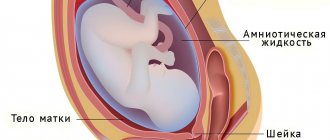What it is?
In medical practice, there are two concepts: timely and untimely rupture of amniotic fluid. The second name refers to the rupture of the bladder membrane before the fetus can be called full-term, namely, until the 37th week of pregnancy. This phenomenon can occur in artificial and natural ways:
- Natural premature rupture of amniotic fluid is when a patient’s labor begins ahead of schedule.
- With the artificial method, doctors pierce the bladder if there are strong indications to induce labor, when there is a direct threat to the life of the baby or mother.
The water may also drain completely, when all the fluid comes out of the bladder at one time, or gradually, over several hours.
Determination at home
It happens that there is neither the opportunity to purchase pharmacy tests nor the opportunity to get to the maternity hospital. What can an expectant mother do at home on her own? Thoroughly rinse the external genitalia and pat dry with a towel. Spread a cotton sheet on the bed and lie down without underwear. The result is assessed after at least half an hour. We can talk about rupture of the amniotic sac if wet spots remain on the bed, which appear or intensify with a change in body position, or with the “cough push” syndrome.
Amniotic fluid discharge
How can you tell when your water is breaking?
A young girl who is carrying a baby for the first time may not realize that she has experienced premature rupture of amniotic fluid. Diagnosis and conclusion of this phenomenon can only be made by an experienced specialist. In total, there are several symptoms that, if they appear, you should immediately call an ambulance:
- A large amount of fluid leaked from the vagina at one time. Frequent urges to go to the toilet (more than 10 times in one hour) should also alert you.
- In addition to clear liquid, bloody spots may also be noticed.
- The stomach sank down and seemed to become much smaller.
- The fetus in the womb stopped making itself felt.
- Pain appeared in the lower abdomen, radiating to the back and sides. They are not permanent.
After the 30th week of pregnancy, the expectant mother should be especially attentive to her body and consult a gynecologist if something bothers her.
Amniotic fluid index
The amniotic fluid index refers to the volume of the liquid part of the amniotic bladder, which can be determined as early as 10 weeks. Normally, the waters themselves are clear or slightly cloudy and odorless.
| Gestational age | Volume of amniotic fluid |
| Up to 10 weeks | 30 ml |
| 14–17 weeks | 100 ml |
| 17–21 weeks | 400 ml |
| 36–38 weeks | 1000–1500 ml |
| A few days before giving birth | 800 ml |
Table - Norms for the release of amniotic fluid
At the initial stages, the volume will be up to 30 ml, closer to the middle the figure grows to 400 ml, and the maximum volume is reached at 37-38 weeks - 1-1.5 liters. By 40 weeks, the volume may decrease to 800 ml, due to the body’s preparation for childbirth, the removal of excess fluid and natural cleansing. What happens when you deviate from generally accepted norms?
Two manifestations of this phenomenon
Medical specialists often distinguish two concepts: premature and early rupture of amniotic fluid. How do they differ from each other?
- We can talk about early effusion when the patient feels severe pain in the lower abdomen, her cervix begins to dilate, and only after these signs does fluid leak out or an artificial puncture of the bladder occurs.
- Premature effusion is a process that occurs in exactly the opposite order.
In addition to premature and early rupture of amniotic fluid, there is such a phenomenon as lateral rupture of the bladder. This can only happen naturally. This means that somewhere on the side of the bubble a small hole has formed through which water partially flows.
Causes causing leakage
How is leakage from the amnion different from leakage before childbirth? Prenatal rupture of the amniotic sac occurs when a rupture occurs in the lower part of the amniotic sac. Regular leakage occurs when there is a tear in the side or upper part of the amniotic sac. What can lead to such a gap:
- Injuries dangerous for the expectant mother: falling on the stomach, blows to the abdominal area.
- Changes in the structure of the amniotic membranes: decreased elasticity, premature degeneration.
- Features of pregnancy: polyhydramnios, multiple births, anatomical location of the child, hydrocephalus of the brain.
- Isthmic-cervical insufficiency: suturing the cervix can provoke a rupture.
- Amniocentesis, chorionic villus biopsy: the bladder is punctured, which can lead to rupture of the amnion.
- Infectious and inflammatory processes: adnexitis, endometriosis, endocervicitis.
- Chorioamnionitis: infectious inflammation of the membranes of the bladder and its internal environment
- Rupture of membranes during previous pregnancies increases the risk of water leakage during subsequent gestations.
Why did this happen?
The girl who so carefully and tenderly carried her long-awaited baby will undoubtedly ask the most important question about why premature rupture of amniotic fluid occurs. There are several main reasons:
- Very large fruit or high water content. The mother's body is no longer able to cope with such a huge load, which is why it begins to prepare for labor.
- A natural phenomenon is premature rupture of amniotic fluid when a woman is preparing to become a mother of more than two babies at once. Doctors say this is a normal reaction of the body.
- Often the cause of this disorder is a pathology of the mother’s organs, for example, she has an irregularly shaped uterus, a cervix that is too short or long, blood circulates poorly and does not enter the placenta in sufficient quantities.
- This can also happen after the expectant mother has suffered an infectious or viral disease. It had a negative impact on the course of pregnancy. Because of this, the bubble became inflamed and a rupture occurred.
- Such a negative moment can be caused by absolutely any abdominal injury if a woman falls, hits or lifts a heavy object.
- Very often the culprit in this situation is excessive intervention by doctors.
- Sometimes the patient herself becomes the culprit of her condition. Rupture can occur due to excessive smoking, drinking alcohol, poor hygiene, constant exposure to stressful situations and intense physical activity.
Premature rupture of amniotic fluid during a premature pregnancy can occur between 22 and 37 weeks; it is during this period that doctors recommend that women be careful about their health in order to avoid unpleasant situations.
What is the function of amniotic fluid
Before a baby is born, he grows for 9 months in his small house in his mother’s belly called the “fetal sac.” It consists of 2 membranes: chorion and amnion. The chorion is its outer part, dense and elastic, which forms a closed space and serves as a barrier to infections that could threaten the baby. The inner part of the bladder - the amnion - is responsible for the formation of fluid, which performs many functions on which the life and health of the baby depends.
Functions of amniotic fluid
Nutrition . Amniotic fluid is nutritious. The baby “floating” in it gradually swallows it in small portions and even absorbs the necessary substances into its skin.
Protects against injury. The amniotic fluid softens all shocks and pressure from the outside world, acting as a shock absorber and preventing the walls of the uterus from squeezing the baby and the umbilical cord.
Envelops you in silence and warmth. In the amniotic fluid, even the loudest sounds are muffled and do not frighten the baby. It is also warm and cozy, since a constant temperature regime is maintained in the fetal bladder.
Protects against diseases. Together with the outer shell of the chorion, infections and diseases that exist outside the mother’s womb and pose a serious threat to the still unformed body are not allowed inside.
Causes of premature rupture of amniotic fluid
What causes the premature outflow of water, scientists cannot answer with absolute certainty. But several of the most common factors are named.
Intrauterine infection and inflammation of the genital organs. These diseases most often accompany premature pregnancy. In every third woman with premature rupture of amniotic fluid, positive cultures from the genital organs are detected. In addition, it turned out that these bacteria are able to penetrate into the amniotic sac and through intact membranes, thereby infecting the child. The infection causes the cervix to ripen prematurely and secrete enzymes that cause the placenta to detach, the fertilized egg to soften and rupture. Moreover, the shorter the pregnancy, the higher the risk of rupture.
We also recommend reading: White discharge during pregnancy
Narrow pelvis and abnormal position of the child. With such risks, PROM usually occurs early, that is, when labor has already begun, but the uterus has dilated no more than 8 cm. In this case, the risk to the health of the woman in labor and the child is minimal.
Isthmic-cervical insufficiency. Due to the weakness and insufficiency of the cervix, the fetal bladder protrudes, its bottom is easily infected and easily ruptures even with minor physical exertion.
Instrumental intervention during pregnancy. This only applies to procedures during which amniotic fluid is examined. Ordinary examinations with mirrors or sexual intercourse do not lead to its outpouring.
Bad habits of a pregnant woman. PROM most often occurs in women with low social status, smokers and drug users. Pregnant women with anemia, vitamin deficiency, and those taking hormonal medications for a long time are also at risk.
When the baby no longer needs amniotic fluid
During normal labor, amniotic fluid is released when the cervix is fully or almost fully dilated. That is, at the end of the first stage of labor. There are 3 of them in total.
- Preparation for childbirth, during which the cervix opens.
- The passage of the child through the birth canal and his birth.
- The postpartum period, when the “place” goes away.
It is during the first stage that the birth canal is prepared for the birth of the child: the internal and external os gradually merge, the cervix is smoothed. By the beginning of the 2nd, the uterus should open 10-12 cm to allow the baby to pass through unhindered. Literally on the eve of this stage, the amniotic fluid should be released. This is ideally called timely waste of water. But it happens when the water breaks even before the baby is ready to leave the mother’s womb. Depending on the time when this happened, they are divided into premature and early rupture of amniotic fluid.
Early rupture of amniotic fluid is when contractions have already begun, but the cervix has not yet dilated. In this case, labor activity may be very weak. Labor may be prolonged, causing obstetricians to encounter fetal hypoxia or intracranial injuries.
Even more dangerous may be premature rupture of amniotic fluid, which occurs as a result of premature rupture of the membranes “PROM”. A quarter to a third of all preterm births are caused by PROM. It is also the cause of about 20% of all perinatal deaths.
Deviations of uterine development and multiple pregnancies
Injuries. Most often, ruptures of the membranes occur due to abdominal injuries, falls or blows.
We also recommend reading: Sagging belly during pregnancy
How to determine premature rupture of amniotic fluid
Depending on the degree of rupture of the membranes, a different clinical picture is observed. If the gap is large, then the fluid pours out noticeably for the pregnant woman. Its quantity is quite large, it is usually odorless and colorless. Due to loss of fluid, the fundus of the uterus shortens and labor soon begins.
We recommend reading: Dill during pregnancy, Garlic during pregnancy, Beer during pregnancy
It is more difficult for a pregnant woman to guess about small cracks in the amniotic sac, from which a small amount of water leaks. However, they can be mixed with vaginal discharge and generally go unnoticed. In this case, a woman should be alert to the following symptoms:
- the discharge has become more abundant and watery;
- when lying down, the discharge does not decrease;
- lower abdomen ache;
- blood appears in the discharge.
In case of such phenomena, a woman should consult a doctor without wasting time.
The sooner treatment is started, the lower the risk of serious complications.
How to diagnose small ruptures and leakage of amniotic fluid
Suspicions of water leakage can be easily confirmed or refuted at home using a special test - amniotest. This is a test - a strip that determines the acidity of a liquid. The fact is that vaginal secretion has an acidic environment, while amniotic fluid is alkaline. And if they mix, a test can find out.
To carry it out, you need to apply the vaginal contents onto a strip. If it turns blue or green, this indicates the presence of amniotic fluid. But in 15% of cases, the results of such a test are erroneous due to urine or blood.
Nowadays, the Amniosure test, which uses a different technology, is considered more popular because of its accuracy - it detects a special protein.
If it is difficult to do the analysis at home, a doctor will make the diagnosis. It has several more methods for identifying anomalies:
- Using mirrors, the doctor can detect fluid leaks through the cervical canal. It usually gets worse when coughing, sneezing or straining;
- An ultrasound will help determine the amount of amniotic fluid, but is not informative if a small amount of fluid is lost;
- amniocentesis procedure, when a puncture is made in the anterior abdominal wall. It is informative, but increases the risk of complications.
When do doctors decide to puncture the bladder?
It is worth talking separately about those situations when doctors decide to provoke untimely rupture of amniotic fluid. Doctors’ tactics usually become like this if:
- A woman complains of acute pain in the lower abdomen.
- She has a temperature of more than 38 degrees for a long time.
- Excessive hemorrhage occurred, most often this indicates placental abruption.
- During pregnancy, there is a strong Rh conflict.
- If the baby is in an incorrect position in the womb, it is better to induce labor earlier before it reaches a large size.
- If the placenta is low.
All of the above points are a direct threat to the life of the mother and her child. Accordingly, in order to hope for a successful outcome, doctors decide to induce labor ahead of schedule. Using a special metal hook, the bladder is pierced, which causes premature rupture of amniotic fluid. This procedure is absolutely painless, since there are no nerve endings in the bladder.
Examination upon admission to hospital
As soon as a girl suspects that a large amount of water has come out of her vagina, she should immediately consult a doctor. He should do the following diagnostics:
- Register the call, accepting all necessary documents from the patient, including an application for medical assistance.
- Take a medical history by listening and recording all the pregnant woman’s complaints.
- Do a gynecological examination on a chair.
- Take all necessary tests, measure temperature and pressure.
- An ultrasound is required; it is this diagnostic that allows one to assess the overall picture of the condition of the fetus in the womb.
Based on the research, the specialist makes a decision on his further actions. The expectant mother must agree with him, having learned the complexity of the situation. Otherwise, she may harm her own health and the baby.
Symptoms of OV: smell, color, consistency, volume
It can be difficult to distinguish amniotic fluid. It has no specific symptoms and is easily confused with urine or vaginal discharge.
The smell of the agent is barely perceptible; some women in labor note that it is slightly sweet. The consistency is similar to regular water. Usually transparent, slight cloudiness is allowed at the end of the period. Sometimes it is green, red is an alarming sign, because... often indicates disturbances in the physiological state of the fetus.
The volume of amniotic fluid depends on the gestational age:
- 13 weeks - approximately 50 ml;
- in the second trimester - 500 ml;
- in the third - 1 l.
IMPORTANT! If, with abdominal tension (turning, bending, coughing, sneezing, etc.), a woman notices an increase in discharge, this may indicate leakage of amniotic fluid.
Several possible solutions
It is also worth talking about what way out of the situation medical specialists can offer when they have found out the cause of premature rupture of amniotic fluid.
- If partial leakage occurs, then they try to maintain the pregnancy at least until the 37th week so that the baby continues to fully develop. But in this case, the patient must be under constant supervision. She will be prescribed appropriate treatment: droppers, suppositories and tablets.
- Inducing labor if there is a direct threat to the life of the mother or fetus. In this case, the natural process of childbirth takes place. The premature baby will be in specialized conditions (hyperbaric chamber) and will continue to develop there under the supervision of doctors. Usually the risk to the mother in this case is minimal.
Fortunately, due to the frequency of such situations, obstetricians have extensive experience and know what measures need to be taken, so in most cases they are able to save patients.
Green waters: causes, risks, consequences
Amniotic fluid turns green when it contains meconium (original feces). Occurs, as a rule, with fetal hypoxia - with a lack of oxygen, the anal sphincter relaxes. As a result, the fetus may experience destruction of pulmonary surfactant and paralysis of the lung due to the action of meconium lipids. Respiratory failure may not develop immediately after birth.
Green discharge
Possible consequences
As mentioned earlier, if a woman has a ruptured bladder, she must definitely call an ambulance. Otherwise, several unfavorable moments may appear:
- Hypoxia. It is caused by the fact that the child does not receive enough oxygen for a long time. Usually doctors take measures that can save the baby.
- Due to insufficient fluid and air, the baby dies right in the womb of the woman.
- The lining of the uterus will become very inflamed, and then long-term treatment will be required.
- There will be weak labor activity, due to which this process will drag on for a long time, more than 8 hours.
- Death of a patient.
It is worth noting that the breaking of water is a very dangerous process, after which you cannot remain without medical care, since the outcome can be the most unfavorable.
How to distinguish amniotic fluid leakage
As a rule, vaginal secretions or mucous plugs that come off piece by piece (if these are the last stages) have a thicker and more viscous (mucous) structure. Unlike urinary incontinence, which often accompanies the expectant mother in the last trimester, effusion is easily distinguished by color and smell (if it is a one-time phenomenon), and by the inability to stop the discharge by tensing the urogenital muscles (in case of heavy loss).
Mucus plug
It should also be taken into account that leakage occurs as a result of the mucous plug leaving and the cervix opening (in the case of the onset of labor), or in the case of minor losses, a small rupture of the amniotic sac occurs in its middle or upper part.
Preventive measures
Every woman who wants to give birth to a healthy child is concerned with the question of how to avoid premature rupture of amniotic fluid. There are several preventive measures. If you follow them, the risk of such a phenomenon is reduced several times:
- It is recommended to take a conscious approach to the family planning process: do not have abortions, do not have multiple sexual partners, and avoid diseases of the genital organs.
- Before pregnancy, partners should undergo a thorough examination, especially to exclude Rh conflict.
- Constantly see a doctor during pregnancy, take the necessary tests and undergo research, which will help prevent possible complications in the early stages.
- Lead a healthy lifestyle three months before conception and the entire process of bearing a baby: do not smoke, do not drink alcohol, eat right, spend more time in the fresh air and avoid stressful situations.
- Do not lift heavy objects.
However, there is no guarantee that this phenomenon will be completely avoided; in some cases it occurs due to the individual characteristics of the body.
How to reduce the risk of premature rupture of membranes
To minimize the risk of PIOV, it is necessary to take a responsible approach to pregnancy.
Plan it in advance, be fully examined for various infections beforehand, and if they are detected, treat them. Already before conception, start eating fully and properly, take multivitamins, give up bad habits and, most importantly, think only about the good. We wish you a safe pregnancy and an easy delivery at term. Take care of yourself and be healthy!
When is there no reason to worry?
In some cases, this phenomenon is completely natural. There are a number of situations when you should not worry about this:
- If premature rupture of amniotic fluid occurs during a full-term pregnancy, that is, in the period from 38 to 42 weeks.
- In the absence of other symptoms: pain, bleeding, temperature, abruption or low location of the placenta.
- The waters receded in small quantities.
In all of the above cases, you should consult a doctor, a specialist will take adequate measures, and the solution to the situation will be favorable for everyone.
Symptoms of slow leakage
We can talk about leakage of amniotic fluid during pregnancy if:
- You notice a sudden flow of liquid moving along the length of your legs
- Your underwear is wet
- Slight discharge or trickle
The cause of a small leak may be difficult to determine. Therefore, it is better to go and consult with a gynecologist on this issue. Continuity of flow indicates leakage.
Leaking amniotic fluid may also be indicated if you continue to experience wetness even after you have emptied your bladder.
About integrity
As it has already turned out, the water is leaving due to a violation of the integrity of the bladder. It’s worth talking about this separately. After conception, the embryo is formed in the uterus, and the amniotic sac forms around it. This is the favorable environment in which the baby will develop for 9 months. If its integrity is violated, oxygen stops flowing into the bladder, blood circulation and gas exchange suffer. Accordingly, the child is in danger at this moment. Therefore, it is very important that he is born as early as possible.
Simple test
You can find out that water is leaking at home.
To do this, you need to buy a test at the pharmacy. You need to place an indicator in a test tube with liquid; if after a few seconds the famous two stripes appear on it, then you can pack your things, call an ambulance and go to the maternity ward. The period of pregnancy is very sensitive, important and responsible. During it, a new life is formed. Every young mother should treat her body with the utmost care during this period, listen to doctors and take all necessary precautions. Only in this case can you avoid adverse consequences and become the happiest mother of a healthy baby.
What threats does premature rupture of membranes pose?
It depends on how much time passes between the time the water breaks and the start of contractions. This period is called the latent period, and the longer it is, the higher the risk of complications. For example, 6 hours is already considered a fairly large period of time. Most often during this period, microbes enter the fetal bladder through cracks or ruptures and inflammation of the membranes begins.
We also recommend reading: How to treat thrush during pregnancy?
This complication is accompanied by increased body temperature, the mother’s heart rate increases to 100 beats per minute, and the child’s – 160. The woman feels pain in the uterus, as well as purulent discharge. In this case, delivery is necessary.
After the rupture of water, premature placental abruption is also observed, which is accompanied by severe bleeding and oxygen starvation of the child. In this case, the woman in labor is expected to give birth early, and the baby may develop various diseases:
- immaturity of the lungs, which means respiratory distress syndrome;
- possible occurrence of cerebral palsy;
- deformation of the bones of the skeleton and limbs.
Women in labor often experience postpartum hemorrhage, cervical ruptures and inflammation of the uterus.








